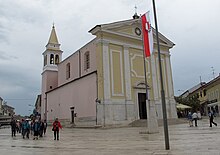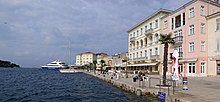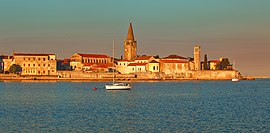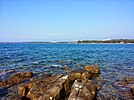Poreč
Poreč
Parenzo Parenso | |
|---|---|
| City of Poreč Grad Poreč Città di Parenzo[1] | |
Poreč | |
| Coordinates: 45°13′38″N 13°35′45″E / 45.22722°N 13.59583°E | |
| Country | |
| County | |
| Government | |
| • Mayor | Loris Peršurić[2] (IDS) |
| • City Council | 17 members |
| Area UTC+2 (CEST) | |
| Postal code | 52 440 |
| Area code | 052 |
| Website | porec |
Poreč (Croatian pronunciation:
The town is almost 2,000 years old, and is set around a
History


Roman period
During the 2nd century BC, a Roman
In the 3rd century the settlement had an organised
Middle Ages
With the fall of the
Modern period
The population was decimated by plague at the end of the 16th and the beginning of the 17th century. After the fall of the Venetian Republic, Parenzo came under the sovereignty of the Habsburg monarchy.
Between 1805 and 1814, Parenzo was part of the Napoleonic Kingdom of Italy and then of the Illyrian Provinces, nominally part of the First French Empire. After this period it was again annexed by the Habsburgs, with the Monarchy reorganized into the Austrian Empire. In 1844 a steamship connection was established between Parenzo and Trieste.
In 1861, under Austrian Littoral Parenzo became the seat of the regional Parliament,[citation needed] with schools, administrative and judiciary offices, and other services. During this time, it slowly became a shipbuilding center. It also became a popular tourist resort for the Austro-Hungarian aristocracy. Between 1902 and 1935 the Parenzana (from the name 'Parenzaner Bahn'), a narrow-gauge railway line connected the town to Trieste.
After 1918, it became part of the Kingdom of Italy. In 1944, the city was bombed by the Allies 34 times, damaging 75% of the city.[6]
Yugoslav period (1945/47-1991)
In 1947, two years after
From 1945 to 1991, Poreč was a city of
Independent Croatia (since 1991)
In 1991 Croatia became an independent state. Today, the city's Italian name (Parenzo) is also used in an official capacity.[8][9]
Climate

Situated on the western coast of Istria and cooled by sea breezes, the local
Nearby sightseeing sites

The
Lim Bay is a 12-km long estuary with the aspect of a narrow canal, created by the river Pazinčica by eroding the ground on its way to the Adriatic Sea. Quartz boulders are occasionally found here, exposed by the sea.
Vegetation and agriculture
The landscape is rich in
Transportation

Road traffic is the primary form of transportation. Poreč is well-connected with the rest of Istria and with larger cities such as
Economy

Traditionally, economic activities have always been connected with the land and sea. The only significant industry in the area is food processing, but Croatia's ongoing integration into the broader European economy has led to Poreč seeing growth in its trade, finance and communication sectors. However, the primary source of income is tourism.[12]
Real estate prices are very high due to the city's prime location.
Demographics
| Year | Pop. | ±% |
|---|---|---|
| 1880 | 7,355 | — |
| 1890 | 8,478 | +15.3% |
| 1900 | 10,168 | +19.9% |
| 1910 | 12,439 | +22.3% |
| 1921 | 12,252 | −1.5% |
| 1931 | 12,607 | +2.9% |
| 1948 | 9,862 | −21.8% |
| 1953 | 8,604 | −12.8% |
| 1961 | 8,216 | −4.5% |
| 1971 | 8,820 | +7.4% |
| 1981 | 11,739 | +33.1% |
| 1991 | 14,633 | +24.7% |
| 2001 | 17,460 | +19.3% |
| 2011 | 16,696 | −4.4% |
| Source: Naselja i stanovništvo Republike Hrvatske 1857–2001, DZS, Zagreb, 2005 | ||
According to the 2011 census, the main ethnic groups in Poreč are Croats (74.8%), Istrian Italians (3.2%), Serbs (3.4%), Albanians (2.7%) and Bosniaks (1.95%).[13] Also part of the Parentian people submitted the choice "regional" (as
According to the 2011 census, there are 9,790 residents of the town of Poreč, and with all
- Antonci, population 164
- Baderna, population 240
- Banki, population 17
- Bašarinka, population 90
- Blagdanići, population 15
- Bonaci, population 104
- Bratovići, population 19
- Brčići, population 163
- Buići, population 131
- Cancini, population 158
- Červar-Porat, population 527
- Črvar, population 99
- Čuši, population 20
- Dekovići, population 45
- Dračevac, population 166
- Filipini, population 43
- Fuškulin, population 181
- Garbina, population 68
- Jakići Gorinji, population 18
- Jasenovica, population 50
- Jehnići, population 39
- Jurići, population 3
- Kadumi, population 216
- Katun, population 64
- Kirmenjak, population 48
- Kosinožići, population 99
- Kukci, population 500
- Ladrovići, population 86
- Matulini, population 16
- Mičetići, population 37
- Mihatovići, population 122
- Mihelići, population 43
- Montižana, population 57
- Mugeba, population 180
- Mušalež, population 366
- Nova Vas, population 480
- Poreč - Parenzo, population 9,790
- Radmani, population 241
- Radoši kod Žbandaja, population 115
- Rakovci, population 26
- Rupeni, population 2
- Ružići, population 19
- Stancija Vodopija, population 116
- Starići, population 8
- Stranići kod Nove Vasi, population 177
- Šeraje, population 2
- Štifanići, population 61
- Šušnjići, population 29
- Valkarin, population 44
- Veleniki, population 107
- Vrvari, population 792
- Vržnaveri, population 76
- Žbandaj, population 417
| population | 5748 | 6333 | 7355 | 8478 | 10168 | 12439 | 12252 | 12607 | 9862 | 8604 | 8216 | 8820 | 11739 | 14633 | 17460 | 16696 | 16607 |
| 1857 | 1869 | 1880 | 1890 | 1900 | 1910 | 1921 | 1931 | 1948 | 1953 | 1961 | 1971 | 1981 | 1991 | 2001 | 2011 | 2021 |

Main sights
The town plan still shows the
The Euphrasian Basilica, rebuilt in the 6th century under the Byzantine Empire and bishop Euphrasius, is the most important historical site in Parenzo. It is a protected World Heritage Site, so designated by UNESCO in 1997. Between the 12th and 19th centuries, the city had defensive walls, as the better-known Dubrovnik still does today.
Porec also has one of the smallest streets in Europe the Ulica Stjepana Konzula Istranina.
Tourism


In 1844, the
Today,
Poreč's heritage can be seen in the historic town centre, in museums and galleries hosted in houses and palaces, many of them still private homes as they have been for centuries. In the off season, weekend visitors from Croatia, Slovenia, Austria and Italy visit the area. Sports complexes are developed and used year-round.
Notable natives
Chronologically:
- Giuseppe Picciola, Italian poet (1859–1907)
- Giuseppe Pagano, Italian architect (1896–1945)
- Mario Visintini (1913–1941), Italian flying ace of the Spanish Civil War and World War II
- Licio Visintini (1915–1942), brother of Mario, Italian naval officer during World War II, member of an elite commando frogman unit
- Rita Rusić (1960), Italian actress, singer and producer
- Simon Sluga (1993), Croatian footballer
Twin town and sister cities
 Massa Lombarda, Italy
Massa Lombarda, Italy Siófok, Hungary
Siófok, Hungary- Poing, Germany
See also
- Roman Catholic Diocese of Poreč-Pula
References
- ^ The official site, see also the amendments to the Statute
- ^ "Grad Poreč - Gradonačelnik".
- Wikidata Q119585703.
- ^ "Population by Age and Sex, by Settlements" (xlsx). Census of Population, Households and Dwellings in 2021. Zagreb: Croatian Bureau of Statistics. 2022.
- ^ "Episcopal Complex of the Euphrasian Basilica in the Historic Centre of Poreč".
- ^ [Tragom povijesti gradske knjižnice Poreč]
- ^ Perselli, G. (2001). I censimenti della popolazione dell'Istria, con Fiume e Trieste, e di alcune città della Dalmazia tra il 1850 e il 1936. Unione Italiana-Fiume, Università Popolare-Trieste, Centro di Ricerche Storiche di Rovigno, Trieste-Rovigno.
- ^ The official site of the City of Poreč, Grad Poreč – Città di Parenzo: http://www.porec.hr/prva.aspx?j=cro
- ^ The document stating the official bilingual name of Poreč: http://www.istra-istria.hr/fileadmin/dokumenti/novosti/sjednice_skupstine_2005/21/21-04.pdf p.3.
- ^ "Poreč". Archived from the original on 2008-08-05. Retrieved 2008-07-30.
- ^ "Cave Baredine". Archived from the original on 2009-03-01. Retrieved 2008-07-30.
- ^ "SAS Output".
- ^ "Population by Ethnicity, by Towns/Municipalities, 2011 Census: County of Istria". Census of Population, Households and Dwellings 2011. Zagreb: Croatian Bureau of Statistics. December 2012.
- ^ "Population by Age and Sex, by Settlements, 2011 Census: Poreč". Census of Population, Households and Dwellings 2011. Zagreb: Croatian Bureau of Statistics. December 2012.
External links
 Poreč travel guide from Wikivoyage
Poreč travel guide from Wikivoyage- Poreč – Croatian National Tourist Board Website
- Poreč-Parenzo Tourist Office Official Website
- Poreč – Istria Tourist Board Website
- Istra Music Festival - International Music Festival in Poreč
- Poreč on the Map – Poreč locations on the map with extended info and historical facts
- Giovanni Maria Cassini (1791). "Lo Stato Veneto da terra diviso nelle sue provincie, quarta parte che compren de porzioni del Dogado e dell' Istria". Rome: Calcografia camerale. (Map of Parenzo region).















